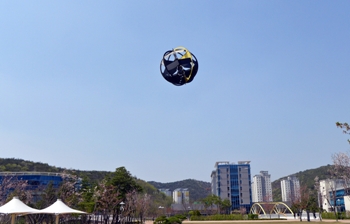Jun 6 2013
UNIST developed an unmanned, globoid uni-copter to monitor disasters and environmental pollution.
 UniCopter
UniCopter
“UNI-Copter, equipped with various sensors and the ability to take-off and land freely, will protect Ulsan from disasters like bushfires or industrial hazards 24 hours a day, 7 days a week.”
Ulsan had a serious bushfire last March. “If we had a kind of unmanned aerial vehicle to monitor and to collect information about the disaster, we could prevent or reduce such an irreparable loss,” said Chair Professor Youm Youngil.
This unmanned UNI-Copter has been developed for the first time in Korea by a research team of Ulsan National Institute of Science and Technology (UNIST). Chair Prof. Youm Youngil, Prof. Bae Joonbum of UNIST, Research Prof. Moon Jae-Sung of UMI (UNIST Multidisciplinary Institute), and Researcher Kim Chunghyun of Ah-Sung Fine Chemical Co., Ltd, participated in this development.
A “*UNI-Copter” is a type of helicopter with one power-driven horizontal propeller called a rotor. Its flight is controlled by the remote control of a pilot on the ground and it is able to send and receive real-time visual images. It is smaller and lighter than *multi-copters, widely researched and developed.
*UNI-Copter: An ‘unique’ helicopter developed by ‘UNIST’ with ‘one(uni)’ rotor
*Multi-copter : A type of rotorcraft with more than two rotors. It is called quadcopter, hexacopter and octocopter with 4, 6, and 8 rotors respectively.
The unmanned UNI-Copter is able to take off and land vertically, to hover, and to fly forwards, backwards and laterally. These attributes allow UNI-Copters to be used in congested or isolated areas to prevent and/or to reduce disasters like bushfires and hazardous chemical accidents.
“UNI-Copter will be very useful to monitor environmental pollution in industrial areas, exposed to hazardous chemicals, and various chemical related industries clustered, like Ulsan,” said Prof. Youm. “It also has a high possibility of being used by the military due to its accessibility and mobility in narrow and densely packed areas.”
Prof. Bae is pinning his hopes on UNIST’s diverse interdisciplinary research environment. “We are trying to apply solar cells and fuel cells of green energy to UNI-Copter’s power engine under UNIST’s convergence research cooperation,” said Prof. Bae. “An autonomous flight feature is under development with GPS (global positioning system) and configurable aeronautical position.”